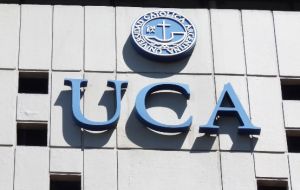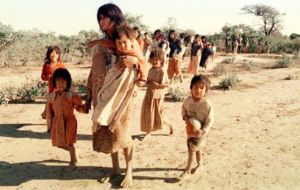MercoPress. South Atlantic News Agency
Poverty in Argentina stands at 27.5% of population, says Catholic University
 The UCA report admits that rates dropped in 2010 and 2011, but have since increased
The UCA report admits that rates dropped in 2010 and 2011, but have since increased Poverty and indigence in Argentina in the last quarter of 2013 again increased and reached 27,5% of the population and 17.8% of households, according to the latest report from the Catholic University Social Debt Observatory, UCA.
The release comes in the midst of a controversy since the Argentine government has refused to make public its latest estimates on poverty arguing that a change in methodology is delaying the indexes.
Indigence was recorded at 3.2% for households and for individuals climbed from 4.9% to 5.5%.
According to the Social Debt Observatory, poverty and indigence percentages effectively dropped in Argentina from 2010 to 2011, but again climbed in 2011, 2012, and 2013.
“The most conservative estimates indicate that poverty dropped significantly between 2010 and 201, from 17.6% to 14.3% of households and from 27.6% to 22.9% for individuals, both rates climbed in 2012 to 15.5% and 24.5% and to 16.5% and 25.6%, respectively”.
However if the basic basket used to measure poverty is considered at its maximum value, “rates both for households and individuals tend to be higher” says UCA.
In this last case, household poverty between 2010 and 2011 drops from 19% to 15.5% but then in 2012 and 2013 is up to 16.9% and 17.8%. This evolution repeats itself with individuals: it first drops from 29.5% to 24.7% between 2010 and 2011, and then climbs to 26.4% in 2012 and 27.5% in 2013“.
However there are more dramatic figures referred to the second half of last year which indicate that there are 15.4 million poor people in Argentina, or 36.5% of the population. These figures have been elaborated by the Institute of Public Thinking and Policies, IPPP, which is made up of staff sacked by the Kirchner couple from Argentina's controversial stats' office Indec.
IPPP also supports a paper published by two economists, Claudio Lozano and Tomás Raffo who argue that in Argentina there are five million people who are 'hungry' or below the indigence line; this is equivalent to 12.1% of the 40 million population.
In 2007 the professional staff from Indec was removed by then president Nestor Kirchner and replaced by political cronies who tailor-made stats to help 'keep inflation down' and GDP growth moderate, so Argentina would limit payments on its sovereign bonds tied to the economy's expansion.
The latest official Indec index, from the first semester of 2013 indicated that poverty in Argentina stood at 4.7%.
IPPP also shows that between 2012 and 2013, the number of poor in Argentina increased by 1.8 million, from 32.7% to 36.5%, while indigence was estimated at 6.3%.
Lozano and Raffo also elaborated a ”hunger and poverty“ chart which shows the province of Chaco as the worst, with 61.6% poverty and 30.4% indigence. Cabinet chief Jorge Capitanish was the elected governor of Chaco before invited to his new role in Buenos Aires.
The districts with the least poverty are the City of Buenos Aires, 13.4%; Tierra del Fuego, 14.9% and the Kirchner turf of Santa Cruz, 22.4%.
The IPPP report also shows that between 2007 and 2013, prices in Argentina climbed 337.6%, four times the official Indec index, with Food and Beverage increasing 597%.
”According to Indec an individual in Argentina can feed adequately with 8.50 Pesos (a dollar at the official rate) per day and a family of four with 26 Pesos (3,40 dollars). But our estimate is 37 Pesos (4.50 dollars) for an individual and 115 Pesos (15 dollars) for a family”, concludes the report.





Top Comments
Disclaimer & comment rules-

-

-

Read all commentspoverty poverty,
Apr 30th, 2014 - 01:01 pm 0nonsense, just other people lies,
Argentina is riding the crest of a wave...
@1 Briton
Apr 30th, 2014 - 06:02 pm 0Yes, a wave of poverty and suffering by the sounds of it.
Perhaps come 2015, we will see just how much damage she has done to her country, the new government is bound to tell all.
May 01st, 2014 - 09:45 am 0Commenting for this story is now closed.
If you have a Facebook account, become a fan and comment on our Facebook Page!